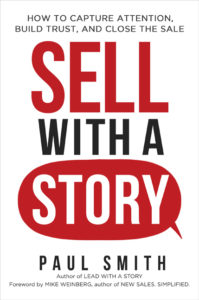Podcast: Play in new window | Download | Embed
Subscribe: RSS
Podcast (sell-with-a-story-series1): Play in new window | Download | Embed
Subscribe: RSS
 {The 15th in a series of the 25 Most Useful Sales Stories.}
{The 15th in a series of the 25 Most Useful Sales Stories.}
“Two roads diverged in a yellow wood.” That’s the opening line of one of Robert Frost’s most famous poems, The Road Not Taken. It describes a difficult choice the narrator has to make between two different paths, and how important it was that he chose the right one.
I’ve called this particular type of sales story a “two-roads” story not because it’s a poem. I’m not suggesting you write poetry for your prospects. Although it might not hurt. I call it that because it’s basically a story describing two paths the buyer can take and it illustrates how important it is to choose the right one.
In essence, it’s the combination of two different types of sales stories. The first is a problem story — a story about a person’s encounter with the problem your product or service is designed to address. And the second is a success story that follows the events of the same (or a similar) person when encountering the same situation, but showing that person making use of your product or service instead, leading to a presumably better outcome.
Obviously, these can be true stories. And most of your sales stories should be. But this is one type of story where many salespeople tend to use hypothetical examples. So, I’ll use that kind of example here.
Example: Upselling a Basketball Hoop
One of Logan Strain’s first jobs out of college was in the call center at an online sporting goods store. So, when someone called to ask about a basketball goal, his sales objective was to get the caller to consider the company’s top-of-the line model that was higher quality but of course also more expensive.
He thought it would be easy. I mean, these people already wanted to buy a basketball hoop. He just needed to get them to buy the best one.
His first few months, he tried walking the caller through all the benefits of the premium model. He said, “I emphasized the more durable pole, the wider backboard, the more comprehensive warranty—all the benefits I learned from the manufacturer.”
But after months of doing it that way, he realized it just wasn’t working. And that didn’t change until he stopped listing benefits and started telling a “two roads” story to put those benefits in the context of a person’s life. In this case, that person is the caller and perhaps the caller’s children.
He started of saying something like:
That’s a fine choice for a basketball hoop. But let’s say it’s two years from now and your kid’s a lot better at basketball, because he’s been practicing. But he can’t make bank shots like he can at school because the backboard’s too narrow.
And maybe he even lowers the hoop to try to dunk and winds up breaking the backboard. Unfortunately, you’ll have to get a whole new one because dunking isn’t covered under the warranty of the one you chose.
But, what if you get the upgraded model and it’s two years from now? He’ll still be able to practice at home, because it’s much closer to the pro systems that he’ll use at the school. And if he does lower the hoop to dunk and shatters the whole thing, the manufacturer will ship you a replacement at no cost.
So, if you plan on living at your house for a long time and want a hoop that will last, this is what I recommend.”
Now, notice that Logan wasn’t using any different facts or selling any different benefits. He was just explaining the impact of those differences in the context of the prospect’s life, one story at a time. In his words:
“They weren’t just bullet points on the manufacturer’s spec sheet anymore. They represented real experiences. They told a better story. ‘A wider backboard’ suddenly became a kid practicing his bank shot at home so he does better during his games at school. ‘A better warranty’ suddenly became having a hoop to play on for years, instead of just doing without a basketball system because it broke.
“And rejecting all those things told a different story entirely—a worse story. By telling these two stories, I forced my prospects to think about which story they want to live with.”
So, you can create your own set of two-roads stories like this by describing two hypothetical narratives. One where someone doesn’t buy what you’re selling, and one where they do.
Use these links to subscribe to this podcast on iTunes or Stitcher, or Podbean.
Source: Sell with a Story: How to Capture Attention, Build Trust, and Close the Sale, by Paul Smith.
—
 Paul Smith is one of the world’s leading experts on business storytelling. He’s a keynote speaker, storytelling coach, and bestselling author of the books Lead with a Story, Parenting with a Story, and Sell with a Story.
Paul Smith is one of the world’s leading experts on business storytelling. He’s a keynote speaker, storytelling coach, and bestselling author of the books Lead with a Story, Parenting with a Story, and Sell with a Story.


 Connect with him via email here.
Connect with him via email here.
Follow him on Facebook, LinkedIn, Twitter, and Instagram.
Sign up for his newsletter here to get one new story a week delivered to your inbox.


Love the details in the story, what parent wouldn’t want to give their kid an opportunity to improve, potentially save money in the long run and buy that better hoop? Great example of real life making a sale. Thank you for the reminder! I’m constantly encouraging clients to share this kind of choice/benefits story.
As always, kudos for great work.
Hugs,
Kristin